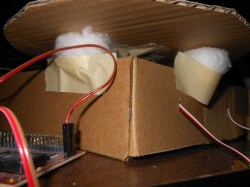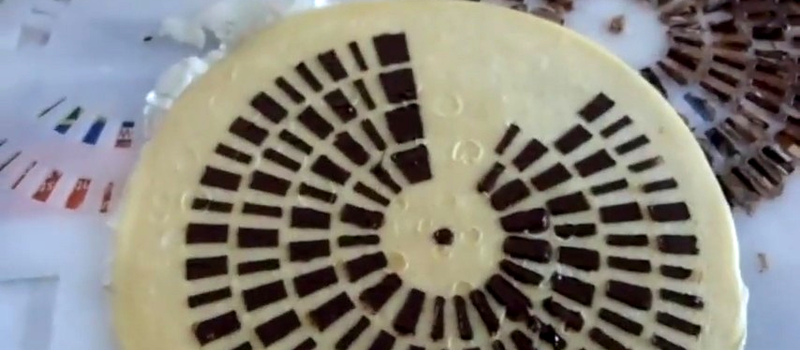You can store arbitrary data encoded in binary as a pattern of zeros and ones. What you do to get those zeros and ones is up to you. If you’re in a particularly strange mood, you could even store them as strips of chocolate on Swedish pancakes.
Oddly enough, the possibility of the pancake as digital storage medium was what originally prompted [Michael Kohn] to undertake his similar 2013 project where he encoded his name on a paper wheel. Perhaps wisely, he prototyped on a simpler medium. With that perfected, four years later, it was time to step up to Modified Swedish Pancake Technology (MSPT).
 Highlights of the build include trying to optimize the brightness difference between chocolate and pancake. Reducing the amount of sugar in the recipe helps increase contrast by reducing caramelization, naturally. And cotton balls placed under the spinning cardboard platform can help stabilize the spinning breakfast / storage product.
Highlights of the build include trying to optimize the brightness difference between chocolate and pancake. Reducing the amount of sugar in the recipe helps increase contrast by reducing caramelization, naturally. And cotton balls placed under the spinning cardboard platform can help stabilize the spinning breakfast / storage product.
Even so, [Michael] reports that it took multiple tries to get the sixteen bytes (bites?) of success in the video below. The data is stenciled onto the pancake and to our eye is quite distinct. Improvement seems to be more of an issue with better edge detection for the reflectance sensor.
What is it with digital electronics and pancakes? We honestly can’t count the number of pancake-making robots we’ve featured over the years. Which suggest? Automating the production side of the storage medium! If you could print out an infinite tape of data pancakes, would you be able to make a Turing machine? If you decide to answer this question, let us know!















haha! so scrumptious this data! – delicious!
In my 15th birthday I enclosed my age in Unix time with white and black chocolate balls.
Should be Nibble Only Memory -Nom, Nom, nom
Ping [BigMac]! You still remember our “pizza disk” discussions in the 8 bit days?
cool I like
good job.
Is there any ECC, just in case a bit is eaten?
A spare ladle of batter and a bag of chocolate chips standing by?
I’ll write it all down for you on a piece of paper. I promise. In return I want the pancake.
You know (or may not know) how CD-RWs work? The disc has a layer of polymer that has 2 states, crystalline, and amorphous. The crystalline state is shinier, so by measuring reflectance with a laser, you can read back whether a particular chunk of CD-RW is amorphous or crystalline. That’s your 0 and 1.
By heating, and fully melting, a spot of the stuff, it turns to liquid, then cools and sets in the crystalline form. But by heating it partly, it just melts a bit, goes floppy, and this is what we call the amorphous phase.
And then I was thinking of the time I made toffee. Well a few times. Think that’d work with sugar? Or some combination of sugar and other stuff (commonly known as a “recipe”) you might be able to conjure up something suitable. Might not be suitable for the bit density CD-RWs have, but anything at all would be pretty impressive. As long as it’s repeatable. You could squeeze in a lot of redundancy, to make anything with a 51% chance of being one way over the other, into a reliable storaage medium.
Originally I was thinking, why not use a heating element to “print” bits on the pancake, rather than the slower, manual, chocolate method. But then my brain got all excited and some of the archaic knowledge from decades gone by bubbled up and showed it’s hand, and now here we are.
If you patent it, I want half the money. But I’ll settle for a quarter.
I’d take a byte out of that